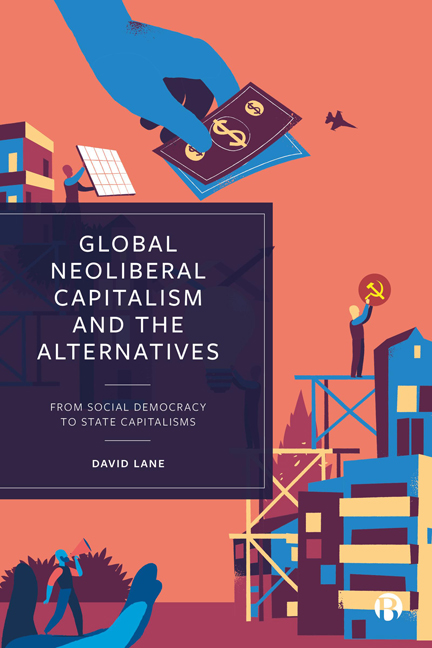Book contents
- Frontmatter
- Contents
- List of Figures, Tables and Boxes
- About the Author
- Acknowledgements
- 1 Introduction
- 2 Global Neoliberalism and What It Means
- 3 Neoliberalism: A Critique
- PART I Socialist Contenders and Their Demise
- PART II Capitalist Globalisation and Its Adversaries
- Appendix 16A Social Formations: Patterns of Coordination and Control
- Appendix 16B Regulated Market Socialism
- Index
9 - From Industrial to Global Capitalism
Published online by Cambridge University Press: 20 January 2024
- Frontmatter
- Contents
- List of Figures, Tables and Boxes
- About the Author
- Acknowledgements
- 1 Introduction
- 2 Global Neoliberalism and What It Means
- 3 Neoliberalism: A Critique
- PART I Socialist Contenders and Their Demise
- PART II Capitalist Globalisation and Its Adversaries
- Appendix 16A Social Formations: Patterns of Coordination and Control
- Appendix 16B Regulated Market Socialism
- Index
Summary
In previous chapters I showed how political movements and governments met the challenges of national and world politics after the Second World War. Policies were influenced by two major interconnected and cumulative developments. First, occurred a transformation of manual worker based developed industrial economies to a predominantly nonmanual service sector. Economies of the advanced nations experienced the rise of transport, trade, electronic communications, insurance, education, banking, health, recreation and research. Industrial production continued, often in an attenuated form, but with a smaller more skilled work force, which was able to harness machines and robots to perform not only industrial tasks but commercial and personal ones. The armies of factory workers were gradually replaced by a much smaller number of scientific, technical and professional employees. Second, a qualitative shift took place in the spatial relationships between countries and regions consequent on the globalisation of economic and social relations. These developments together may be described as a movement from national industrial capitalism to globalised post-industrial capitalism. Such structural developments have conditioned the framework of politics.
The groundwork for theories of ‘post-industrial’, ‘informational’ or ‘knowledge’ based societies may be traced back to the 1960s. The works of Clark Kerr, J.K. Galbraith and Daniel Bell all contributed to the concept of post-industrial society. A consequence of the changes they identified is that knowledge and intellectual property became major economic resources. In post-industrial society, the use and ‘codification of theoretical knowledge’ became a fundamental component of the economy. Knowledge is ‘a set of organised statement of facts or ideas, presenting a reasoned judgement or an experimental result, which is transmitted to others through some communication medium in some systematic form’. Post-industrial society was composed of three domains: the tertiary sector (transportation), the quaternary sector (trade, finance, insurance, real estate) and the quinary sector (health, education, research, government and recreation). These sectors provided a social base for a ‘post-industrial’ type of politics. What also emerged after the third quarter of the twentieth century were multi-national corporations, which strongly influenced states, and financial companies, rather than productive enterprise, which drove investment.
- Type
- Chapter
- Information
- Global Neoliberal Capitalism and the AlternativesFrom Social Democracy to State Capitalisms, pp. 157 - 182Publisher: Bristol University PressPrint publication year: 2023

